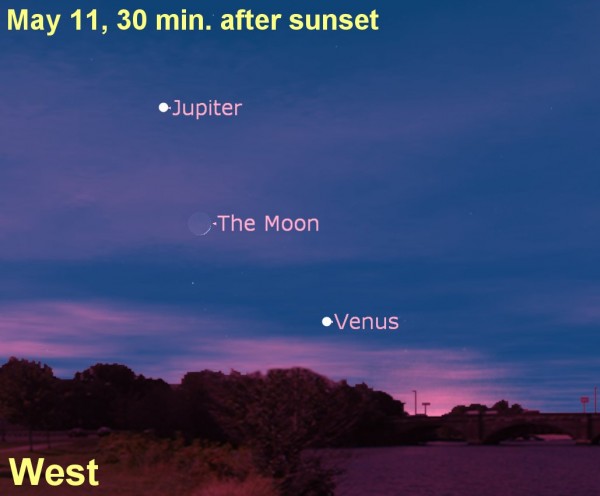5 Sky Events This Week: Return of Venus, Solar Eclipse
Here at National Geographic, we’ve discovered that readers love their space. So today we’re launching what we hope will be a far-out new feature: What to look for this week in the night sky. The second week in May will bring a mixed cosmic bag of shooting stars, an eclipse, and some worlds playing tag with each other.
Eta Aquarid Meteors. Starting at nightfall on Monday, May 6, straggler meteors from the Eta Aquarid shower should still be visible zipping through overhead skies across the globe. While rates of shooting stars will be significantly less than on peak night, May 5, it should be possible to see at least a half dozen per hour from dark skies throughout the first half of the week.
Venus Returns to Evening Skies. Starting on Tuesday, look for Venus—the second innermost planet—to start emerging from the evening twilight very low in the west-northwest. While it’s a challenge to hunt down within the sunset’s glare, Venus’ visibility will improve as it rises higher in the evening sky in following weeks.
Annular Solar Eclipse. On Thursday to Friday, the moon will cast its shadow on the Earth, making the sun appear as a ring of fire in the first solar eclipse of 2013. Visibility of the full eclipse can be seen from Queensland, Australia, on May 10 at 22:37 UT and Papua New Guinea and the Solomon Islands on May 9, at 23:00 UT. In Hawaii, a partial eclipse can be seen with just less than half the sun’s disc covered on May 9 at 3:50 p.m. local time.
The crescent moon will be paying a visit with Jupiter and Venus this week. Illustration via Starry Night Software/Andrew Fazekas
Moon Joins Venus. On Friday evening the very young and thin crescent moon passes Venus in the very low west-northwest horizon. This pairing will be a challenge to observe because it will appear very low in the sky, so it’s best to find a location that has a free line of sight down the horizon. Venus will be only less than 2 degrees away from the moon—equal to the width of a thumb at an outstretched arms length. Binoculars will make it much easier to spot the cosmic pair in the bright twilight glare.
Moon Joins Jupiter. On Saturday and Sunday evening, watch the western sky at dusk for the waxing crescent moon to glide past Jupiter, the largest planet in the solar system. On Saturday the moon will be to the lower right of the gas giant. By Sunday the moon will have jumped to the upper left of the bright, star-like Jupiter. The two worlds will appear to be separated by about 6 degrees—a little more than the width of a fist held at an outstretched arm’s length.(Posted by Andrew Fazekas in StarStruck on May 6, 2013)












